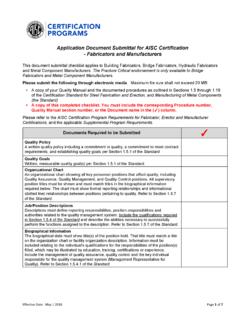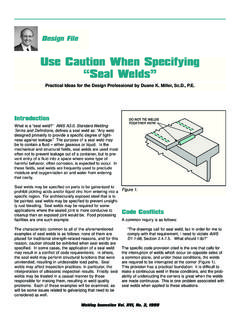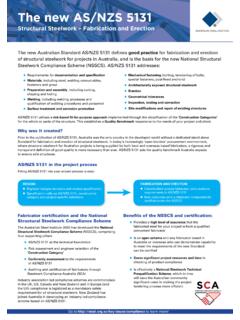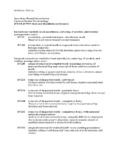Transcription of 30755 steelwise camber web - AISC
1 SSpecifying CambersteelwiseJuly 2006 The Steel Solutions Center has the resources and rules of thumb you need to properly specify beam connection toideas + answersSPECIFYING BEAM camber CAN PROVIDE SUBSTAN-TIAL DEPTH AND WEIGHT SAVINGS TO A FLOOR SYSTEM AND AN ENTIRE BUILDING. Though there are times when specifying beam camber can be advantageous, there are situations in which it is also impractical. The Steel Solutions Center has completed a comprehensive re-view of past and current research to guide you in correctly specify-ing beam camber . Cost data was obtained from conversations with structural steel fabricators, mills, and service centers and represents the most current national averages. These suggestions are based on the summarized results of the Steel Solution Center s research and will help you achieve the greatest benefit when specifying is a beam cambered?
2 Cold cambering is the most common method of inducing cam-ber on a beam. A common method is to place the beam in a press that is about 22 to 24 long with two hydraulic rams spaced at the third points. The rams push the stress in the beam past the yield point, which produces a permanent strain. This third-point load-ing produces a reasonably uniform camber curve that is ideal in counteracting the effect of uniform loading. For camber greater than 1 or 2 , the beam will probably re-quire multiple pushes in the machine to achieve the desired cam-ber. For beams with a span of more than 40 , the press is run three times: first at the beam center, and then the beam is re-positioned and run on each third point. For very long beams, it can be run up to five times. Most fabrication shops surveyed had machines that could handle up to 27 -deep beams. For deeper beams, contact your fabricator, as each shop has its own maximum and minimum sizes that it accommodates.
3 The second method available is heat camber . It is generally much more time consuming and labor intensive than cold camber -ing and therefore rarely used. The process requires a worker to apply heat with a torch to the flange and web at uniformly spaced points. Normally this method is only employed if the depth of a beam exceeds the capacity of the cold- camber are some rules of thumb that apply to cambering?Do not specify camber on beams that require less than cam-ber losses would make it ineffective. On the contract documents, camber should be specified in increments. Beams that are cam-bered must be compatible with a fabrication shop s cambering jig. In most cases, this means you cannot camber : Beams with a total length less than 24 : The cambering jig pins the ends of a beam at approximately 20 to 22 apart. A beam of less than 24 will not have enough end distance beyond the pins to work.
4 Beams with web thickness less than or equal to : They are subject to web crippling in the camber following conditions are unfavorable to cambering due to construction practicality issues: Spandrel beams: Cladding system connections are difficult to coordinate. Beams in moment frames: There are issues with fit-up for a connection that is supposed to be both rigid and 90 . Beams shallower than 14 deep: The webs are usually too slender, and it should be relatively easy to bump the shape up to a W14. Beams subject to significant twist. Beams with cantilevers. Beams with braces framing into them. Beams with a non-uniform cross-section: They are difficult to fit into the jig. Beams with significant non-symmetric loading: camber is designed to counteract uniform is natural mill camber and how do I account for it?Two types of camber exist in design: natural mill camber and in-duced camber .
5 Natural mill camber happens as a result of the roll-ing and cooling processes inherent in steel manufacturing. Toler-ances for natural mill camber are described in ASTM Specification A6. This standard gives a maximum natural mill camber or sweep for any beam as 1 8 times the length of the beam in feet divided by 10. For a 30 span this works out to be 3 8 . Members specified with no camber must be erected with any natural mill camber in the up-ward direction. Most often, natural mill camber is not an issue and is not in the ballpark of the tolerances described above. What camber tolerances should I specify on my drawings? What tolerances should I expect in the field? Tolerances for induced camber are given in Section 6 of AISC s Code of Standard Practice for Steel Buildings and Bridges. It states that if a beam arrives at the fabricator s shop with 75% of its specified camber , no further cambering is required.
6 All other members with a length less than or equal to 50 have a tolerance of 0 / + for induced camber . All other members with a length greater than 50 BY ERIKA WINTERS DOWNEY JULY 2006 MODERN STEEL CONSTRUCTION have a tolerance of 0 / + ( + 1 8 per ad-ditional 10 ). The beam will not have nega-tive tolerance as long as the fabricator has to induce camber . The final camber mea-surement is verified in the shop, where an inadequacy can be corrected. There will most likely be losses in cam-ber as a result of transporting the steel from the mill or fabrication shop to the site. A rule of thumb is that these losses may be about 25% of the induced camber . They may also offset any extra camber induced in the beam as a result of the positive camber tolerance. Most often, a fabricator induc-es more camber than is necessary. By the time the steel is transported to the site and losses have occurred, the remaining cam-ber is very close to the originally specified structural engineer does have the leeway to specify his or her own camber tolerances in the contract documents.
7 Tol-erances of 0 / + have been noted as being realistic. However, tighter tolerances are associated with greater fabrication costs. If possible, speak to the fabricator on the job to decide on a reasonable tolerance. How much load should I camber a beam for?There are a few different schools of opinion about this. A literature review pro-duced answers ranging from 80% of dead load to dead load, super-imposed dead load, and 10% of live load. If one does decide to take super-imposed dead load or live load into account, the camber pertaining to this load should not exceed . At the 1996 North American Steel Construction Con-ference, two papers were presented advo-cating the use of 80% of beam deflection calculations when specifying camber . The basis for these papers is this: real connec-tions are not theoretical pins and have some fixity to them.
8 As a result, the deflection of the member is less than that of a theoretical pinned-end beam. When determining the amount of load to camber , the method of construction and the frequency and duration of expected live loads are both aspects one would be wise to take into account. Consider what you want the finished floor profile to be. Does the floor need to be completely flat at the end of construction, or would you like a slight upward camber to remain after construc-tion to account for some super-imposed dead load and regularly occurring live load?Lastly, engineers tend to overestimate loads as a matter of being conservative. When specifying camber , one should make as accurate an assessment as possible to the dead loads on a is the optimum floor slab profile: constant thickness or constant elevation?To the engineer, the ideal slab profile should be a constant thickness slab.
9 The screeds to finish the pour should follow the curve of the cambered beam. For the con-tractor, it is probably easiest to produce a constant elevation slab where the screeds are run at one level and do not follow the cambered beam curve. Pouring a constant elevation slab pres-ents problems to the design engineer. Con-crete could pond at the center of the beam if there is not enough camber to accommo-date all of the dead load, possibly overload-ing the beams. Inversely, if there is extra camber on the beam, it is possible the slab will be too shallow at center and shear studs could protrude from the top of the slab. For a typical office building, it is prefera-ble to have a small amount of camber remain (about ) after pouring the slab so that the beam can absorb some superimposed dead load and live load deflection before becom-ing concave. The engineer of record should specify the desired finished floor profile in the general notes of a project.
10 All parties involved should meet and agree upon the best approach for the proj-ect. Do not promise the owner a perfectly flat floor cambering is not an exact sci-ence. The results depend on the skill level and experience of the jig operator. Even for a design executed perfectly, there will be variations in floor elevation. How does cambering affect connection design?Cambering is typically done at the fab-rication shop after the beam has been cut to length and connection holes are drilled. Because cambering imparts a radial curve onto the beam, its end connections will not be perfectly square. This can cause fit-up problems if not addressed. For typical filler beam shear connections shear plates, tees, and angles simply use short-slotted holes to account for the connections not being exactly square. It is not advised to camber beams that will have moment connections because these connections, by design, need to be at right angles.













